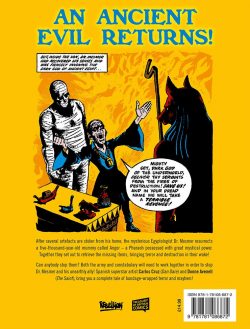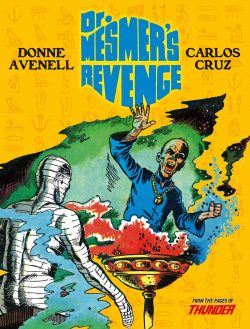

By Donne Avenelle, Carlos Cruz & José Ortiz (Rebellion Studios)
ISBN: 978-1-78108-687-2 (TPB/Digital edition)
Win’s Christmas Gift Recommendation: Timeless Terror for Kids of Every Land and Vintage… 8/10
It’s time for another sortie down memory lane for us rapidly diminishing oldsters and hopefully a fresh, untrodden path for new fans of the fantastic seeking a typically quirky British comics experience.
This sinister selection delivers another stunning nostalgia-punch from Rebellion’s superb and ever-expanding Treasury of British Comics, collecting seminal shocker and film-fuelled fright fest Dr. Mesmer’s Revenge.
The strip debuted in Lion and Thunder running from October 16th 1971 to October 21st 1972, with this book of the dead also including two epic appearances from the Lion Annuals for 1973 and 1974. The series is a typical example of the manner in which weekly periodicals functioned back then: a solid support trip offering a change of pace from straight action or fantastic adventure as supplemented by comedy pages.
Dr. Mesmer’s Revenge was crafted by British legend Donne Avenell, who began his career before WWII at in the editorial department of Amalgamated Press (which evolved into Fleetway/IPC on household name Radio Fun. Born in Croydon in 1925, Avenell served in the Royal Navy during the war before returning to publishing: editing an AP architectural magazine whilst pursuing writing for radio dramas and romances under a slew of pseudonyms.
He returned to comics in the 1950s, with many contributions to childhood icons like War Picture Library and Lion, directing the sagas of The Spider, The Phantom Viking, Oddball Oates, Adam Eterno and more. He co-wrote major international features like Buffalo Bill, Helgonet (The Saint) and The Phantom for Swedish publisher Semic, created the strip Django and Angel and toiled on assorted Disney strips.
In 1975, with Norman Worker, he co-wrote Nigeria’s Powerman comic which helped launch the careers of Brian Bolland and Dave Gibbons. Avenell was equally at home on newspaper strips such as Axa (1978-1986, drawn by Enrique Romero), Tiffany Jones and Eartha (illustrated by John M. Burns), and worked in television, writing shows like The Saint and their subsequent novelisations. He died in 1996.
Series illustrator Carlos Cruz González was born in 1930 in Andalusia. His large family moved to Malaga when the Spanish Civil War began in 1936, and again to Buenos Aires in 1949. By that time, Carlos was already a professional artist for local newspapers. In South America, whilst working in a flour mill, he moonlighted as a designer at publisher Abril.
In the 1950s he created covers for Idilio, Nocturno and Más Allá, and became fill-in artist on features like Hugo Pratt’s Sargento Kirk before graduating to his own strips like Colt Miller, Indio Suarez and Santos Palma (written by Hector German Oesterheld). Going international he contributed to German periodical Pip and worked on Egmont’s edition of The Phantom.
Moving back to Malaga in the 1960s, Cruz began a 20-year career with Britain’s Fleetway and DC Thomson, drawing war, action, horror, romance and girls’ fiction stories. Prolific and gifted, his strips appeared in many include Battling Boffins in Tiger, Sgt. Rock – Paratrooper (Tiger and Hurricane), Union Jack Jackson (Warlord), Crabbe’s Crusaders, Roamin’ James: Space Pilot! and Mighty McGinty in Buster, Moonie’s Magic Mate and The Pillater Peril in Smash, Eagle’s Blood Fang, Wendy, M.A.S.K. and jewel in the crown Dan Dare.
He also worked in the Spanish market on strips like Juanjo for Trinca, and crafted “Kelly” for Holland’s Tina, and in later years joined the art team on Sweden’s En Hombre Enmascarado. Carlos Cruz died in April 2018.
In the sixties and seventies the British liked their comics characters weird, wild, utterly amoral, flagrantly inept and invariably corrupt to the core. These days it’s a requirement we only demand from and venerate in politicians and public servants. One thing we have adored above all other things is a great, properly flamboyant villain. We always enjoyed a strange, extended love affair with what can only be described as “unconventional” (for which feel free to substitute “weird” or “creepy”) heroes.
So many stars and putative role models of our serials and strips have been outrageous or just plain “off”: self-righteous voyeurs-vigilantes like Jason Hyde, deranged vigilante geniuses like Eric Dolmann, self-absorbed outsiders like Robot Archie, arrogant, morally ambivalent former criminals like The Spider or outright racist supermen such as Captain Hurricane…
We also made much of (barely) reformed criminals like Charlie Peace and evil masterminds in the manner of The Dwarf, Black Max, Grimly Feendish, The Snake and today’s particular Menace to Society…
In the respectable English suburb of Blackford stands a strange house. Shaped like a pyramid it has giant cat statues as gates and ancient monuments dotted around the walled estate. Here dwells reclusive Egyptologist Dr. Mesmer and the world is faced with a terrifying crisis from the moment burglars rob his cellar temple of valuable – and arcanely powerful – ancient artefacts…
Outraged, Mesmer unleashes magical 5000-year-old mummy Pharaoh Angor, animated cat-idol Bulbul and sundry other supernatural relics to take back his property, punish the thieves, the dealer who fenced them and all those who bought the items. Only young police constable Tom Stone, and his initially disbelieving superior Inspector Moffat, are aware of what’s really going on…
Over weeks Mesmer’s retaliations and missions revealed incredible feats of horror, until he regained his collection, with the cops always overmatched but scoring some brief victories. As the strip evolved, Mesmer moved beyond righteous indignation, and – after an accidental time-swap – took all concerned back to meet the living pharaoh Angor and his noble enemies. The return to the present saw the doctor change tactics and try to conquer the modern world, with merely mortal gadfly nuisances Stone and Moffat his only opposition…
Once the series concluded, the doctor made a brace of encores in the Lion Annual for 1973 and 1974. The first tale saw how respected archaeologist Dr. Wrath was caught robbing tombs in the Valley of Kings and how his subsequent punishment led to uncovering the mummy of Angor, shattering vengeance inflicted upon his accusers and a little name change. The second yarn sees the power-hungry villain in Dorset, stealing an ancient sun-stone relic and awakening something even mighty mummy Angor cannot defeat…
Moodily chilling and evocatively compelling, Dr. Mesmer’s Revenge is a timeless treat for comics buffs and fear fans: one you’d be well advised to sample soon.
© 1971, 1972, 1973 & 2019 Rebellion Publishing Ltd. All rights reserved.
